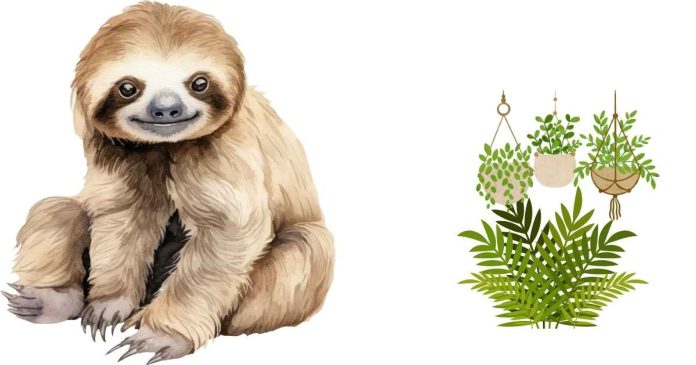Sloths are herbivores, meaning they primarily eat plants. Their diet consists mostly of leaves, but they can also consume fruits, flowers, and occasionally some other plant matter. The types of plants that sloths eat vary depending on their species and their habitat, but here’s a breakdown of their primary food sources:
1. Leaves
Sloths are folivores, meaning their diet is predominantly made up of leaves. They have evolved to specialize in eating leaves, which are often tough to digest due to their high fiber content and low nutritional value. Sloths have a slow metabolism and a highly specialized digestive system to break down these leaves.
- Tree leaves: The majority of a sloth’s diet consists of leaves from a variety of trees and plants found in the rainforests where they live.
- Sloths are selective feeders and typically prefer young, tender leaves over older, tougher leaves. The leaves they eat often come from the following trees and plants:
- Cecropia trees: This tree is common in tropical rainforests and produces leaves that are softer and more digestible. Some species of sloths, especially the Brown-throated sloth (Bradypus variegatus), are known to eat Cecropia leaves.
- Mangrove trees: In coastal areas, sloths might feed on the leaves of mangrove species.
- Pigeon pea (Cajanus cajan): A leguminous plant often found in tropical areas, which sloths may eat.
- Guava leaves: Sloths in some regions may also consume guava leaves, especially in areas where guava trees grow in abundance.
2. Fruits
Although leaves make up the bulk of their diet, sloths also occasionally consume fruits. They are not as dependent on fruits as some other herbivores, but they will eat them when available. The types of fruits sloths may eat include:
- Fruits from Cecropia trees: In addition to leaves, sloths will also eat the fruit of Cecropia trees when it is in season.
- Berries: Sloths may eat small berries or fruits from the trees they inhabit, especially in tropical regions where fruiting plants are abundant.
- Tropical fruits: On occasion, sloths may feed on other tropical fruits if they are within reach, such as figs or papaya.
3. Flowers
Sloths are known to eat certain flowers when they are available. They may eat the flowers of the same trees they feed on for leaves, especially if the flowers are soft and easily accessible. Some examples include:
- Cecropia flowers: Sloths may also eat the flowers of the Cecropia tree, though they typically prefer the leaves.
- Other tropical flowers: Depending on the species of sloth and their location, they may eat flowers from other plants like Passionflowers or Balsa trees.
4. Other Plant Matter
Occasionally, sloths might eat other parts of plants, like buds or tender shoots, although leaves make up the majority of their diet. They will also consume mosses, fungi, or other plant-based matter that grows on the trees where they live, though this is less common.
5. Specific Preferences by Sloth Species
- Three-toed sloths (Genus: Bradypus): These sloths are more specialized in eating leaves from specific trees, particularly Cecropia and other tree species with tender leaves.
- Two-toed sloths (Genus: Choloepus): While they also primarily eat leaves, two-toed sloths tend to have a slightly broader diet, which might include more fruits, flowers, and even some insects or small animals on rare occasions.
6. Digestive Adaptations
Sloths have a very slow metabolism, which is an adaptation to their low-nutrient diet. Their stomachs are highly specialized to digest the tough, fibrous leaves slowly, which can take several days. Sloths have a four-chambered stomach that helps break down plant matter efficiently over an extended period. As a result, their digestion process can take up to a month to fully process a single meal of leaves.
Summary
Sloths primarily eat:
- Leaves from a variety of trees, especially Cecropia trees.
- Fruits (though less frequently, especially from the same trees they eat leaves from).
- Flowers and buds from certain plants.
- Occasionally, other plant matter such as moss or fungi.
Their diet is relatively low in nutritional value, and they have evolved to survive on this diet by moving slowly and having a very slow metabolism. This helps them conserve energy, as their food takes a long time to digest.


